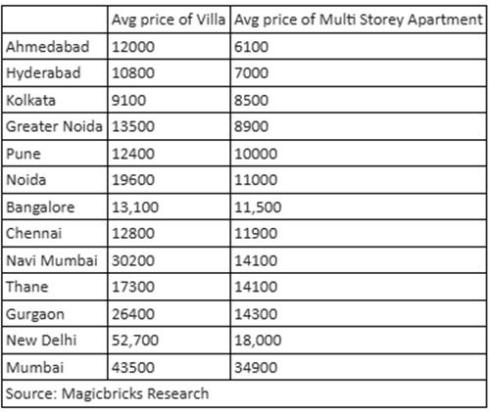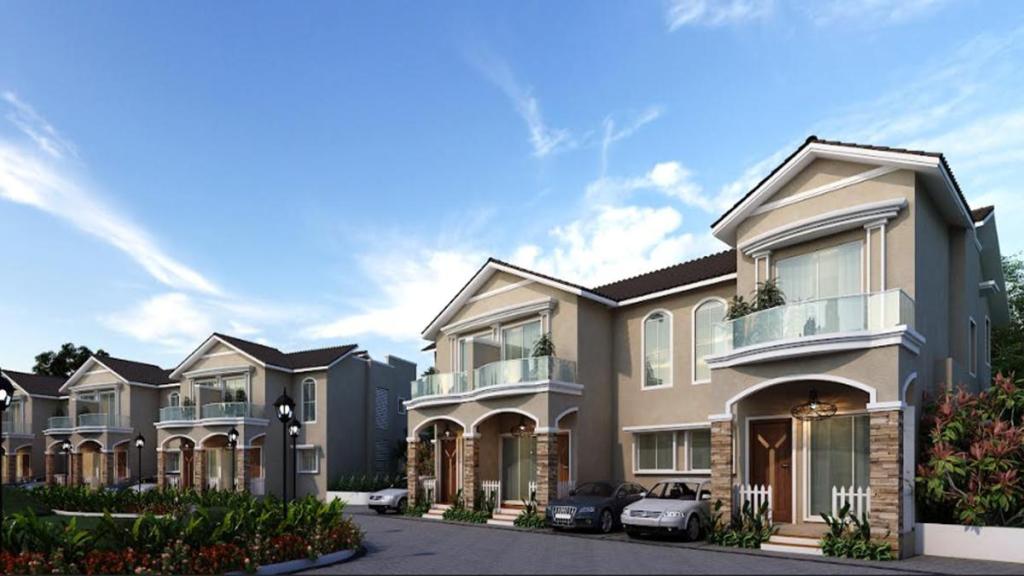India’s villa market is witnessing unprecedented growth, driven by rising affluence, evolving lifestyle preferences, and increasing investments from both domestic and NRI buyers. With the post-pandemic shift towards spacious living and premium amenities, luxury villas are becoming a preferred choice for high-net-worth individuals.
Additionally, rapid urbanization and strong economic performance have fueled demand, leading developers to launch high-end projects across major cities. As this trend gains momentum, the villa segment is set to play a significant role in shaping India’s evolving real estate landscape.
According to Magicbricks, in 2024, prices of villas appreciated significantly in cities such as Navi Mumbai (55.7% YoY), Greater Noida (50% YoY) and Noida (40% YoY). Between October and December 2024, the average price of a villa in Greater Noida reached Rs 13500 psf as compared to Rs 8900 psf for multi-storey apartments. Similarly, prices of villas in Noida averaged Rs 19600 psf as compared to multistorey apartments which averaged Rs 11000 psf.

In general, villas are often more expensive than apartments due to factors like land costs and the perception of luxury living. However, they also hold a more promising return on investment, making it a lucrative option.
Pradeep Mishra, CMD, ORAM Developments, says, “Villas, especially ones situated within gated housing societies, have witnessed strong traction due to elevated aspirations and the need for more living space. They are constructed in niche and exclusive areas, providing privacy along with world-modern amenities centred on wellness, leisure, and comfort. More importantly, with land prices rising, the factor of land ownership plays a major role in terms of better ROI and exclusivity of ownership.”
“Investing in a villa at a prime location, therefore, is seen as a financially-prudent decision that provides appreciation and stability in the long run with prices equivalent to those of high rise, but comes with additional ownership of land, thereby lending a better value over the years,” adds Mishra.
According to industry experts, the villa market in India is growing at a healthy pace, driven by evolving consumer behavior, cutting-edge design themes, and growing investments by non-resident Indians (NRIs).
Dr. Sachin Chopda, Managing Director, Pushpam Group, says post-pandemic, there is a strong preference for large, private homes that are both luxurious and functional. “Homebuyers are increasingly looking for homes that have separate workspaces, personal outdoor spaces, and increased privacy. This trend is supported by Knight Frank data, which shows that high-end housing units worth more than Rs 10 million represented 41% of overall sales during the first half of 2024, showing a 51% year-over-year growth,” he adds.
Trends in Design and Amenities
Contemporary villas are now adopting eco-friendly and technology-driven designs. Developers are using smart home elements, energy-efficient systems, and green materials to appeal to the green buyer.
The Pushpam Group, for instance, has recently launched Manhattan-style villas — named 21 Enclave — in Karjat, Maharashtra. Offering a choice of 10 units of 3BHK and 11 2BHK units, each home comes with a private pool and beautifully-landscaped gardens, capturing an ideal balance of privacy and sophistication.
Chennai-based realty developer Casagrand has also recently entered the Tiruppur market with the launch of 137 exclusive 3 & 4 BHK apartments along with 36 signature 4 BHK villas. Similary, Godrej Properties Ltd has unveiled India’s first 3D-printed G+1 villa at Godrej Eden Estate, Maan Hinjewadi, Pune, in association with Tvasta Engineering.
Investment Potential and NRI Interest
Villas and second homes have increasingly become a desirable option for investment, offering the potential for significant capital appreciation and steady rental income. Non-Resident Indians (NRIs) are particularly drawn to these types of properties, including vacation homes, resort residences, and villas, due to favorable exchange rates and the desire to maintain a tangible connection to their homeland.
“Our ‘Kamanewala Ghar’ idea captures this appeal by providing investors with ownership, enjoyment, and returns from their homes without the hassles of maintenance, as these residences are professionally maintained and offer guaranteed rental yields,” says Chopda.
The expansion of India’s villa segment, thus, is driven by evolving consumer desires for luxury and spacious living, innovative and sustainable design principles, and strong investment interest from HNIs and NRIs. This convergence positions the villa market as a dynamic and promising sector within the real estate industry.

